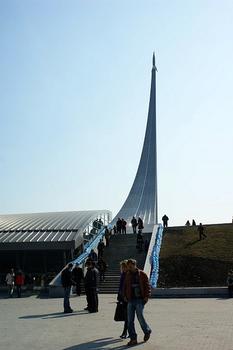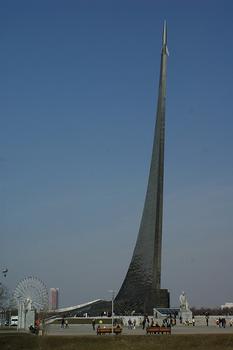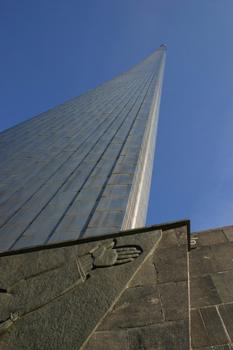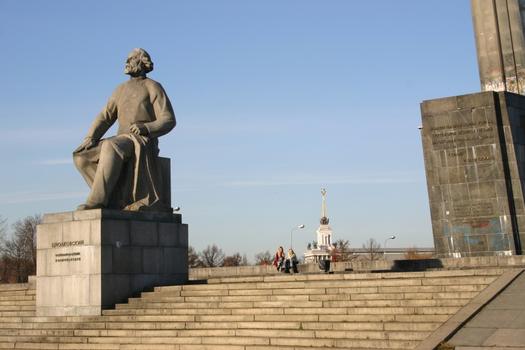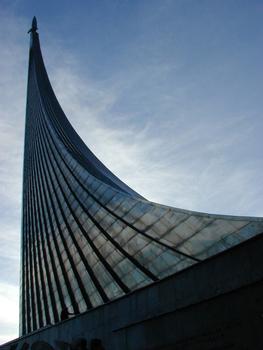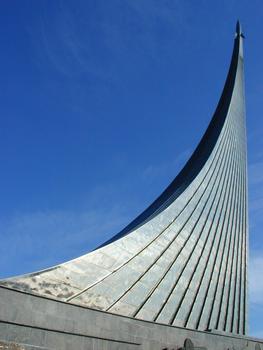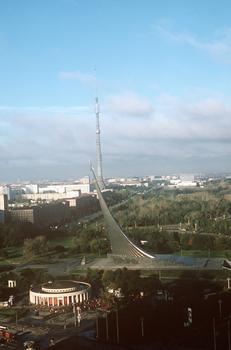General Information
| Completion: | 1964 |
|---|---|
| Status: | in use |
Project Type
| Function / usage: |
Monument |
|---|
Location
| Location: |
Moscow, Central Federal District, Russia |
|---|---|
| Coordinates: | 55° 49' 21" N 37° 38' 23" E |
Technical Information
Dimensions
| height | 107 m |
Materials
| veneer |
titanium
|
|---|
Excerpt from Wikipedia
The Monument to the Conquerors of Space (Russian: Монуме́нт «Покори́телям ко́смоса», tr. Monumént "Pokorítelyam kósmosa", IPA: [mənʊˈmʲent pəkɐrʲˈitʲɪlʲɪm ˈkosməsə]) was erected in Moscow in 1964 to celebrate achievements of the Soviet people in space exploration. It depicts a starting rocket that rises on its exhaust plume. The monument is 107 meters (351 feet) tall, has 77° incline, and is made of titanium. The Memorial Museum of Cosmonautics is located inside the base of the monument.
Location and surroundings
The monument is located outside the main entry to today's Exhibition of Achievements of the National Economy (VDNKh), in the northeastern part of Moscow, near Prospekt Mira ("Peace Avenue"). The easiest access is from the VDNKh subway station.
Since the 1960s, this part of Moscow in general has had a high concentration of space-themed sights and names: besides the monument and the museum under it, the grand "Cosmos" pavilion in the Exhibition Centre displayed many artifacts of the Soviet space program. Many streets in the area have been named after the precursors of the space program (Nikolai Kibalchich, Friedrich Zander, Yuri Kondratyuk) and its participants (Sergey Korolyov).
The Cosmonauts Alley south of the monument features busts of Soviet cosmonauts.
The choice of this part of Moscow for space-related names and monuments may have been inspired by the fact that Prospekt Mira runs toward the north-eastern suburbs of Moscow, where, in Podlipki (today's Korolyov City) much of the space program was based. Korolyov himself lived in a house within a few blocks from the monument, which is now preserved as Korolyov Memorial Museum (Russian: Дом-музей академика С. П. Королёва).
History
In March 1958, a few months after the launch of Sputnik 1, a competition was announced for the best design of an obelisk celebrating the dawn of the Space Age. Out of some 350 proposals, the design by sculptor A.P. Faidysh-Krandievsky and architects A.N. Kolchin and M.O. Barshch was chosen. The grand opening of the monument took place on October 4, 1964, on the day of the 7th anniversary of the Sputnik 1 launch.
The monument was designed to accommodate a museum in its base. However, it took until April 10, 1981 (two days before the 20th anniversary of Yuri Gagarin's flight) to complete the preparatory work and open the Memorial Museum of Cosmonautics. The museum reopened on April 12, 2009 after three years of renovations.
Design and sculpture
The main part of the monument is a giant obelisk topped by a rocket and resembling in shape the exhaust plume of the rocket. It is 107 meters (350 feet) tall and, on Korolyov's suggestion, covered with titanium cladding.
A statue of Konstantin Tsiolkovsky, the precursor of astronautics, is located in front of the obelisk.
A poem in Russian on the front of the stone base of the monument base says:
И наши тем награждены усилья, Что поборов бесправие и тьму, Мы отковали пламенные крылья Своей Стране И веку своему!
Approximate translation:
And our efforts were rewarded once overcoming rightlessness and darkness by forging blazing wings To our Nation And the age of ours!
Below, in smaller letters, is the dedicatory statement: "В ознаменование выдающихся достижений советского народа в освоении космического пространства сооружен этот монумент" ("This monument was constructed to manifest the outstanding achievements of the Soviet people in space exploration"), and the year, 1964.
Both sides of the monument base, in their front parts, are decorated with haut- and bas-reliefs depicting men and women of the space program: scientists, engineers, workers, their occupations indicated by appropriate accoutrements of the professions. Notable figures include a computer programmer (or perhaps some other computing or telecommunications professional) holding a punched tape, a cosmonaut wearing a space suit, and Laika the space dog, first animal to orbit Earth.
No contemporary Soviet politicians are depicted in the monument either (that would violate the convention existing in the post-Joseph Stalin Soviet Union against commemorating living persons in this fashion), but the crowd on the right side of the monument are moving forward under the banner of Vladimir Lenin.
Text imported from Wikipedia article "Monument to the Conquerors of Space" and modified on July 23, 2019 according to the CC-BY-SA 4.0 International license.
Participants
Currently there is no information available about persons or companies having participated in this project.
Relevant Web Sites
- About this
data sheet - Structure-ID
20027807 - Published on:
28/03/2007 - Last updated on:
30/07/2014


